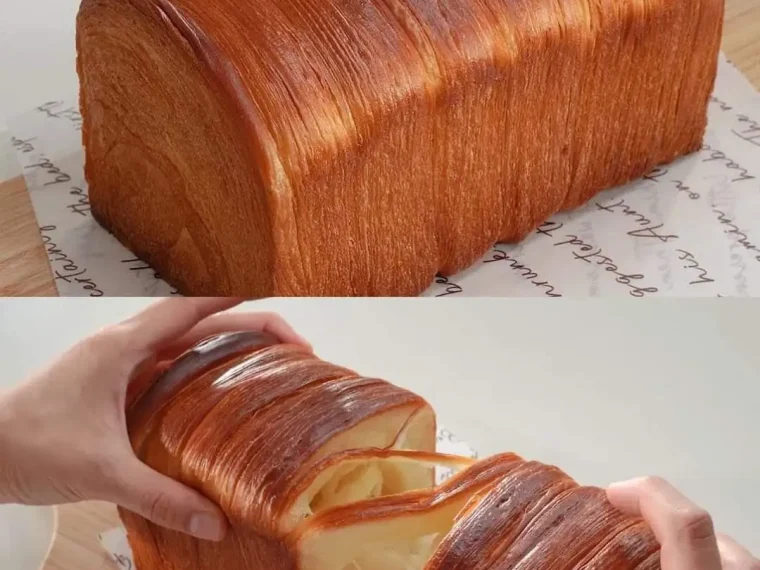This recipe creates a beautifully layered, buttery bread loaf that rivals anything made by a professional bakery. The combination of rich butter and delicate dough creates a tender, flaky texture that is simply irresistible. The process of rolling and folding the dough multiple times ensures that you achieve those perfect layers, similar to what you would find in machine-made puff pastry bread.
Ingredients:
500g bread flour
50g sugar
10g yeast
80g unsalted butter, melted
2 large eggs
250ml milk
10g salt
300g unsalted butter (for folding)
Directions:
Prepare the Dough:
In a large mixing bowl, combine bread flour, sugar, and yeast.
Add the melted butter, eggs, and milk to the dry ingredients. Mix until no dry flour is visible.
Knead the dough roughly for 5 minutes. Then, add the salt and continue kneading for another 7 minutes until the dough becomes smooth and elastic.
Rest and Refrigerate: 4. Cover the dough with plastic wrap or a lid and refrigerate for 30 minutes. 5. After 30 minutes, knead the dough again until it is smooth. 6. Shape the dough into a slightly flattened square, wrap it tightly in plastic wrap, and refrigerate overnight.
Prepare the Butter: 7. The next day, fold a piece of baking paper into a square measuring 16×20 cm. 8. Place the 300g butter inside the paper square and spread it evenly. Refrigerate until the butter is firm.
Roll and Fold the Dough: 9. Sprinkle flour on the dough and roll it out into a rectangle, about twice the size of the butter square. 10. Place the chilled butter square in the center of the dough. Wrap the butter by folding one side of the dough over it, then fold the other side to meet the ends. 11. Fold the dough in half again, wrap it well in plastic wrap, and refrigerate for 30 minutes.
Repeat Rolling and Folding: 12. Remove the dough from the refrigerator, roll it out again into a large rectangle, and fold it as before. Refrigerate for another 30 minutes. 13. Repeat this rolling and folding process one more time, followed by another 30-minute refrigeration.
Final Rolling and Shaping: 14. After the final refrigeration, roll the dough out to approximately 22×17 cm. 15. Place the dough on a tray, cover it with plastic wrap, and refrigerate for 10 minutes. 16. After 10 minutes, trim the protruding end straight and divide the dough into 8 pieces, each cut at 2-3 cm intervals.
Shape the Dough: 17. With the grain of each dough piece facing upwards, press gently with your hand and slightly roll out each piece with a rolling pin. 18. Turn each piece over and roll it up, gently unfolding the end.
Final Fermentation: 19. Arrange the rolled dough pieces into a bread pan. Cover with plastic wrap or a lid. 20. Let the dough ferment in a turned-off oven with hot water for 4-5 hours at 25-27°C (77-81°F).
Bake: 21. Preheat the oven to 190°C (375°F). 22. Brush the surface of the dough with milk. 23. Place the bread pan on an oven tray and bake for 23 minutes. 24. Cover with aluminum foil and bake for an additional 7 minutes. 25. Immediately remove from the oven and release the bread from the pan to cool, preventing moisture buildup.
Nutrition:
Prep Time: 30 minutes (plus overnight resting)
Cooking Time: 30 minutes
Total Time: 1 hour (plus overnight resting)
Calories: 250 kcal per serving
Servings: 8 servings
Why This Recipe Works:
The key to achieving those exquisite layers lies in the technique of rolling and folding the dough with butter, known as lamination. By incorporating cold butter into the dough and repeatedly folding and rolling it, you create multiple layers of dough separated by thin layers of butter. This technique traps steam during baking, causing the layers to puff up beautifully.
Tips for Success:
Keep the Butter Cold: Ensure that your butter is firm but pliable. This helps maintain distinct layers without the butter melting into the dough.
Work Quickly: Roll and fold the dough swiftly to prevent the butter from melting.
Chill Between Folds: Refrigerating the dough between folds helps the butter stay firm and makes the dough easier to handle.
Use a Sharp Knife: When cutting the dough, a sharp knife will help maintain the layers without squishing them.



